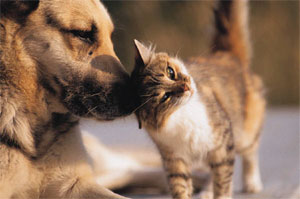Reaching a Détente Between
Your Dogs and Cats
By Margaret Gibbs
Barn cats, alley cats, Siamese cats,
Persian cats-to many dog lovers, cats are not tolerated and
are simply considered the "other" pet. After all, we are
"dog people"-cats are nice, but dogs are our passion.
Cats, though, are
tiptoeing into countless homes, blurring the line between
dog and cat lovers. People are discovering that the two
species can co-exist peacefully, meaning that breeders and
dog trainers increasingly are being asked to help the
process along and to explain differences between the two.
 |
|
Kittens and adult
dogs must be supervised when first introduced,
so that neither animal gets hurt. But it is not
unusual for the animals to become fast friends
despite their biological differences.
|
To some dog lovers, cats
are mysterious, alien beings. They may even arrive in
strange ways, appearing one day and behaving as if they've
always lived on the premises. Sometimes a dog is the first
to notice the newcomer. Lacey, a Pomeranian, was making a
property check on a frigid, winter day when she discovered a
very young kitten lying in a drainage ditch. She immediately
raced back to the house and made it clear that a rescue was
necessary, and owner Maria Betlinski took the feline in.
The kitten, whom
Betlinksi named Independence, began to live among more dogs
than most cats see in a lifetime. The household dogs noticed
that the kitten seemed to have no desire to bicker over rank
and privileges, which suited them.
Betlinski was amazed at
how quickly Independence imitated many of the dogs' social
behaviors directed toward her. While this was going on, she
began to shape the kitten's household manners using positive
reinforcement for behaviors she liked. Despite beliefs to
the contrary, cats, she discovered, could be trained like
dogs-with some important distinctions.
Cathy Crawmer, a
professional animal trainer and author of Here Kitty,
Kitty agrees. Those in the dog world may best know
Crawmer from video footage shown at clicker-training
seminars where she is shown training a cat to run an agility
course.
Crawmer emphasizes one
learning characteristic that differs between dogs and cats:
a cat's attention span is very short. "The average cat will
work for 5 to 10 rewards, and that's it!" Crawmer says,
while a dog will hold its concentration on the trainer a lot
longer.
Cats are easily
distracted. In the midst of highly reinforcing activities a
cat may turn his attention abruptly to something else. By
comparison, most dogs can be motivated to remain on
human-directed tasks for a much longer. This may be the
reason that most people assume cats can't be obedience
trained.
Fighting, Well, Like
Cats and Dogs
Dogs, as well as humans, must learn the unique aspects of
cats if they're to live together. But in many ways, dogs
have a much more difficult time than we do.
"Dogs speak Doggish, cats
speak Cattish, and very frequently the same signs can mean
exactly the opposite," says Stanley Coren, Ph.D., psychology
professor at University of British Columbia and author of
How to Speak Dog (Free Press). He believes that
quite a bit of the distrust and animosity that exists
between dogs and cats stems directly from misinterpretation
of body language.
He points to tail wagging
as an example. In cats, tail-swinging is a "keep your
distance" signal, while in dogs a relaxed wag is a friendly
sign. Dogs raise and stiffen their tails to signal
dominance, whereas cats raise theirs to indicate
friendliness. A cat's upright tail combined with
piloerection indicates fear, whereas a stiff, upright tail
in a dog whose hackles are raised indicates assertive,
aggressive intent. It's easy to see how the misreading of
tail signals alone can result in trouble for both species.
Rolling on the back is
another feline behavior that dogs might misinterpret. Dogs
consider this a sign of submission. Cats use the behavior to
expose teeth and all claws in order to grasp, bite, and
disembowel prey. When a cat presents this behavior, he's
ready to attack. But to the dog, the behavior appears
friendly, so he might decide to sniff out his roommate and
receive an unwelcome surprise.
Coren says that dogs can
learn to read cat signals just as they learn to read human
ones-by trial and error. He says that a puppy and kitten
raised together appear to work out communication problems
with the least amount of difficulty, probably due to their
size and strength. Adult dogs and cats must be supervised
when introduced, with human intervention if needed, so that
neither species sustains physical damage as they learn. If a
peaceful co-existence seems improbable, common sense
dictates that one or the other species isn't up to the task.
In Betlinkski's home, the
resident dogs accepted the kitten, and eventually two more
cats moved in. Cats, if you recall, have a way of doing
that. And although as a dog lover you may swear that only
canines will cross your threshold, it may be one of your own
dogs that changes your mind. Just ask Maria Betlinski.
Margaret Gibbs has a
master's degree in clinical psychology and is a professional
dog trainer, behavior counselor, and author.
|

